"ATLA: Gender Bender" is a fan project which reimagines the cast of "Avatar: The Last Airbender" as the opposite gender.
Don't wanna be here? Send us removal request.
Text
I actually wrote a bonafide FTM Trans headcanon for this Original Character Do Not Steal, because I am completely insane.
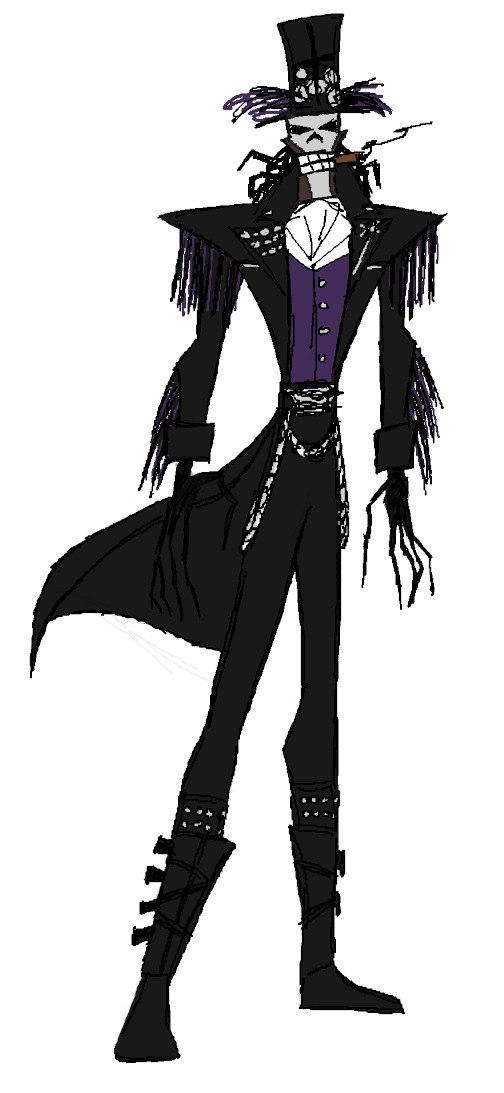
This is a really bad little sketch, but I am working on redesigning this guy. It might take me a while, though.
3 notes
·
View notes
Text

"Toph 1/2"
#toph#toph beifong#avatar the last airbender#genderbending#atla genderbender#rule 63#genderbender#gender bender#genderswap#genderbend#my art
29 notes
·
View notes
Text

"Zuko 1/2"
Alt. under cut:

Like what I’m doing? Consider leaving me a donation via Ko-Fi.
#zuko#prince zuko#rule 63#avatar the last airbender#genderbending#atla genderbender#gender bender#genderbend#genderswap#my art
38 notes
·
View notes
Text

"Sokka 1/2"
Alt. below cut:

Like what I'm doing? Consider leaving me a donation via Ko-Fi.
#avatar the last airbender#atla genderbender#sokka#gender bender#genderswap#genderbend#rule 63#my art
24 notes
·
View notes
Text

ATLA Gender Bender: Transgender Hakoda and Kya
Just for fun, here is a rough sketch of an alternative version of Hakoda and Kya, where they are based on transgender persons observed in indigenous Siberian cultures. Such cultures often had a clear division of labor between men and women, yet various stages of "gender transformation" allowed for some flexibility in these roles. This also seems to be the case for the Southern Water Tribe, as transgender and nonbinary persons were accepted and respected in the Southern Water Tribe.
Hakoda is shown dressed in an unchanged, masculine fashion, as I took inspiration from the "qacikicheca" described by Bogoras in "The Chukchee" (see: archive.org/details/chukchee00…?). The word "qacikicheca" means "similar to a man". In many respects, it is similar to the term "transgender man", and is the only stage of female-to-male "gender transformation" that Bogoras observed. Bogoras also notes that they were rarer than male-to-female "gender transformations", and describes several stages of male-to-female "transformations". The intermediate stages have similarities with being nonbinary, while the more advanced stages are similar to the term "transgender woman". These more advanced stages are called "neuchica", meaning "similar to a woman", or "yirka-laul", meaning "soft man". Kya's appearance is inspired by the description of a "yirka-laul" named "Tilu'wgi", dressed in a fully feminine fashion (see: archive.org/details/chukchee00…). Notably, several other indigenous Siberian groups had a word like "similar to a woman" (such as "koekchuch" or "koiach") to describe the male-to-female transgender and nonbinary persons that were a feature of their culture. This includes the Itelmens, Koryak, Kamchadal, Inuit, and Nivk, to name a few (see: archive.org/details/chukchee00…?). A female-to-male counterpart to the "koekchuch" was rarer among these cultures. Instead, several Arctic and Subarctic cultures had circumstances where girls were raised as boys. This practice was found in the Ojibwe, Kaska, and Greenlandic Inuit (see: books.google.com/books?id=xv_F…). Of note is the following statement: "Gender role change took place in the interests of the community, and not on account of the individual's personal inclinations." This explains how a culture with rigid gender roles would understand transgender persons.
I should note that "qacikicheca" wedded cisgender women, while "yirka-laul" wedded cisgender men. There are no examples of a "qacikicheca" partnering with a "yirka-laul". That being said, it is conceivable that a marriage of this sort would be permitted, since "qacikicheca" were treated as men and "neuchica" were treated as women within Chukchee society. As such, these designs can be viewed as independent of each other, with three possible scenarios:
1. "Qacikicheca" Hakoda and cisgender Kya
2. Cisgender Hakoda and "yirka-laul" Kya
3. "Qacikicheca" Hakoda and "yirka-laul" Kya
Naturally, the only scenario where Sokka/"Sanaaq" and Katara/"Kohara" are biologically related to both Hakoda and Kya would be the third one, with Hakoda and Kya acting as a "reverse couple". In the first and second scenarios, Sokka/"Sanaaq" and Katara/"Kohara" would only be biologically related to one of their parents.
The "yirka-laul" are described as retaining masculine names (see: archive.org/details/chukchee00…?). As such, Kya's name could be the masculine name "Kayuu". That being said, Chukchee males were sometimes given female names to ward off evil spirits (see: archive.org/details/chukchee00…?). For this reason, Kya could still be named "Kya". Since no information was supplied about the names of the "qacikicheca", I'm not sure whether it makes sense to change Hakoda's name. I was able to find a bit of information about girls raised as boys among the Subarctic Ojibwe. Some of these girls were "treated like a boy in all respects", where "her parents do not think of her as fundamentally different from a boy" (see page 119 of: monoskop.org/images/3/34/Mead_…). Additionally, warrior women were given the male title of "brave" (see page 121 of: monoskop.org/images/3/34/Mead_…). It therefore might make more sense for Hakoda to still be named "Hakoda", instead of having a feminine name like "Himekawa".
I was inspired to draw this when I learned about gender and sexuality in the world of Avatar. The Southern Water Tribe is somewhat repressive regarding same-sex relationships, relatively strict with respect to gender roles, but accepting of transgender and nonbinary persons. This is really interesting because it parallels Siberian cultures found in real life. It was really interesting to research these cultures, which can help flesh out how gender identity and sexual orientation would be understood in the Southern Water Tribe.
Like what I'm doing? Consider leaving me a donation via Ko-Fi.
13 notes
·
View notes
Text

ATLA Gender Bender: "Himekawa" and "Kayuu"
As I mentioned previously, the concept behind "ATLA Gender Bender" is to swap the genders of the main cast, and to only swap the genders of adult characters when it enhances the story. Unlike Ursa and Ozai, I don't think the story is enhanced by swapping the genders of Hakoda and Kya. Due to her untimely death, little is known about Kya's personality and history. In the TV series, Hakoda is a pretty simple character, though he is given more focus in the comics. In ATLA, the Water Tribe is arguably the lowest of the four nations in terms of gender equality index. If Hakoda was a woman and Kya was a man, it is likely that Hakoda would have been inside the home when the Southern Raiders invaded. Instead of Kya, female Hakoda would have suffered a noble death at the hands of Yon Rha. Since the position of "chief" is elected in the Southern Water Tribe, male Kya could have become the chief in Hakoda's stead. This seems to be a realistic scenario if the genders of Hakoda and Kya were reversed, but it does not interest me that much. For these reasons, I would rather leave Hakoda and Kya's genders unchanged.
Still, I wanted to try a rough sketch of male Kya and female Hakoda, just for fun. In Hakoda's case, I think it would be interesting if female Hakoda was a rare example of a female chieftain. In designing her, I was inspired by the description of a "powerful woman chief" of the subarctic Kaska (see: books.google.com/books?id=iBIS…). I was unable to find a physical description of this woman chief, so I also referred to information about the Greenlandic Inuit. This culture was selected due to its similarities to Southern Water Tribe culture with respect to gender. Both cultures display a clear division of labor between men and women, yet transgender persons could be found in both cultures (see: avatar.fandom.com/wiki/Souther…). Indigenous Arctic cultures also had a degree of flexibility in the gender role of women, who would be taught to hunt and perform masculine activities to ensure the survival of the community. This seems to also be the case for the Southern Water Tribe, given the non-bender warrior woman "Lirin" and Katara's reaction to the more rigid gender roles of the Northern Water Tribe. I gave female Hakoda a masculine, but not totally masculine, style to match the description of female huntresses of the Greenlandic Inuit. These huntresses were not restricted to the typical gender roles of Inuit women, as they were trained to hunt by their fathers. They are described as girls who "behaved and dressed like men", and it might be appropriate to describe them as "transgender" (see: monoskop.org/images/3/34/Mead_…). However, here I did not intend for female Hakoda to be transgender, but to be like the female chiefs "Running Eagle" and Bíawacheeitchish (see: "Men as women, women as men : changing gender in Native American cultures" by Sabine Lang). Her appearance is also a little inspired by the woman chief shown in the Great Divide. Her hair is meant to suggest that at some point in her past, she wore "hair loopies". Her hairstyle is also inspired by the adjacent culture of Kyoshi Island, where woman warriors like Suki cut their hair short and tie it in a wolf's tail.
With Hakoda reimagined as a female chief, I think her relationship to "Sanaaq" might be similar to that of Toph's relationship to Lin. "Sanaaq" would be an aspiring female warrior who endeavors to live up to her warrior mother's legacy.
Hakoda's name is actually Japanese in origin, where he is named after the Hakkoda Mountains. As such, a potential name for his female counterpart could be "Himekawa", the name of a Japanese river.
Since the men of the Southern Water Tribe were all trained as warriors, male Kya wears a warrior's wolf tail like the other men of the tribe. Would he be an impressive warrior or an unimpressive warrior? I'm not sure. Either way, the idea is that he is still the one found in the home, who sacrifices himself when the Southern Raiders invade. In real life, Inuit clothing was styled differently for men and women, where men's reached to the middle of the thigh, while women's reached below the knees (see: books.google.com/books?id=dQcW…). This generally seems to be the case for Southern Water Tribe men and women. However, the comics "North and South" show Thod and Gilak wearing clothes that extend past the knee (see: avatar.fandom.com/wiki/Thod?fi…). This is why I chose to also give male Kya clothing that extends past his knee. It is also supposed to be something that he might wear while inside the home, rather than fighting a battle. I think a good name for him would be "Kayuu", an Aleut name meaning "his strength" (see page 66 of "Ancient Aleut Personal Names": library.alaska.gov/hist/hist_d…)
Like what I'm doing? Consider leaving me a donation via Ko-Fi.
#avatar the last airbender#hakoda#kya#atla genderbender#genderbend#genderswap#rule 63#my art#my headcanons#gender bender#atla
18 notes
·
View notes
Text
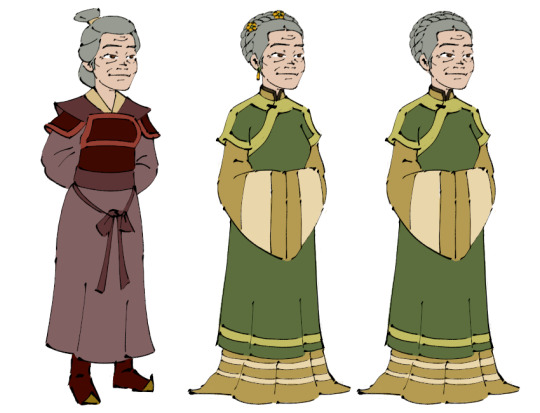
ATLA Gender Bender: "Aunt Ilah"
Originally, I had planned to closely base her Book 1 appearance on female general Qin Liangyu. However, there is one example of a female Fire Nation general shown in the comic "Suki Alone" (see: avatar.fandom.com/wiki/Biyu?fi…). As such, her Book 1 appearance combines features of depictions of Qin Liangyu with the appearance of this female Fire Nation general.
While in Ba Sing Se, Uncle Iroh wore his hair in a Qing Dynasty style queue. I gave "Aunt Ilah" a Qing Dynasty style braided bun to match, shown here with and without jewelry. This hairstyle was worn by Empress Xiaozhuangwen, born Bumbutai (see: en.wikipedia.org/wiki/Empress_…). Fitting of "Ilah", who would still be the rightful heir to the Fire Nation throne.
She is dressed in the same costume as the hostesses of the Jasmine Dragon, since I was too lazy to come up with a concept for an original outfit.
I've been picturing Michelle Yeoh as the voice of "Aunt Ilah".
Like what I'm doing? Consider leaving me a donation via Ko-Fi.
#avatar the last airbender#iroh#uncle iroh#rule 63#atla genderbender#genderbend#genderswap#gender bender#atla#my art
34 notes
·
View notes
Text

ATLA Gender Bender: "Urson" and Ozai
As I started drawing this, I realized that I have no idea what the robes of a Fire Lord's husband look like. So I drew him wearing the cloak that Ursa wears when she is banished.
I intended for his hairstyle to look plain. Without his guan, it looks like a hairstyle that a commoner would wear. This is meant to symbolize how every aspect of his life is controlled within the palace walls, under the thumb of his domineering wife. I think that, if the genders were reversed, Ozai would still be very controlling and oppressive toward her husband to make sure that he does not outshine her in any way.
These are just my headcanons, but I think female Ozai would not enjoy being a mother, and would be devoid of maternal love towards her children. When her firstborn child "Zuka" is born, she is totally negligent. "Ilah" takes on a maternal role instead, and "Urson" is the source of warm parental love. But when her second child "Azulon" is born, she dotes on him more. This is not out of a genuine love for her child, but to inspire jealousy in her firstborn child, who she holds contempt for. Moreover, I think she might favor "Azulon" from a young age as a means of separating a son from his father. She would be a terrible wife and mother who controls every aspect of her family's lives.
I have been imagining Daniel Dae Kim as the voice of "Urson".
Like what I'm doing? Consider leaving me a donation via Ko-Fi.
#ozai#ursa#avatar the last airbender#atla genderbender#atla#rule 63#gender bender#genderswap#genderbend#my headcanons#my art
47 notes
·
View notes
Text
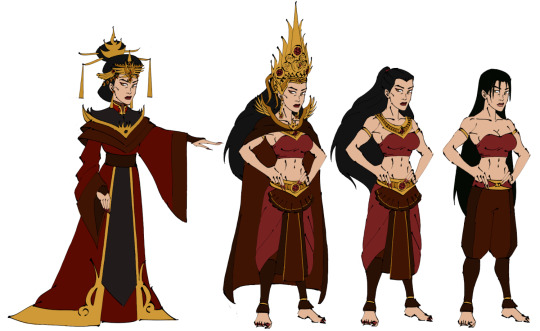
ATLA Gender Bender: Firelord Ozai
"You will learn respect, and suffering will be your teacher."
The principle behind this AU is to swap the genders of the main cast (Aang, Katara, Sokka, Toph, Zuko) and other characters where it enhances the story. This means that most child characters, like Azula and Suki, are also swapped, but adults are swapped on a case by case basis. This is especially true for characters who had a formative influence on the main characters, like parents and other role models. If you swap a given character and their parent(al figure)s, this alters the character's personality more than swapping that character without swapping their parents. Sometimes this effect is subtle, and sometimes it is large. This is why I would avoid swapping the genders of a character's parents, unless it makes sense to do so.
In the case of Zuko's parents, I do not think it detracts from the story to swap their genders. I would even go so far to say that some things are enhanced by swapping both Ozai and Ursa. Female Ozai fits surprisingly well into the role of an "evil empress". "Urson" also works as a "papa bear" character. A female Ozai would contrast well with a female Zuko, serving as a "good queen" "evil queen" dichotomy. I also find it fascinating to think about what would change and what would stay the same if Ozai's gender was also swapped.
I picture female Ozai being no less evil or sadistic as normal Ozai. Unlike Ozai, she would have to maintain the image of a good mother to her children, and a good daughter to her father. This is especially interesting if she is the first female Fire Lord in a line of male Fire Lords. She would be a queen who has to strike the perfect balance of femininity and power in order to please her court. A woman who possesses bewitching beauty to conceal a wicked, sadistic soul. I think she would be very narcissistic and cruel, obsessed with being beautiful and powerful at once.
I attempted to convey this through her design, which could be tweaked in many respects. To explain the rationale behind her design, the Fire Lords of Avatar draw from East and Southeast Asian influences. Firelord Ozai's hairstyle is Chinese inspired (see: atlaculture.tumblr.com/post/65…), but his clothing is Burmese inspired (see: atlaculture.tumblr.com/post/63…). As such, I decided to base the hairstyles of female Fire Lords on East Asian hairstyles worn by female rulers.
It feels inevitable that female Ozai would be compared to Wu Zetian. I wanted to minimize these comparisons, and make it clear that female Ozai is not supposed to be a representation of Wu Zetian. Doing so would unfairly demonize a real historical figure. Still, I could not resist including a couple of elements inspired by Fan Bingbing as Wu Zetian in "The Empress of China" (see: dwvyw8kf1avne.cloudfront.net/s…). This is what inspired female Ozai's red makeup, and the stylized phoenix headdress that she wears. Other design elements are not inspired by Wu Zetian, but other portrayals of powerful queens and empresses in Chinese dramas. Namely, Empress Du Feihong in "The Glamorous Imperial Concubine". I hope that the final design is so stylized that it is clear that she is not supposed to represent a real historical figure. I attempted to simplify her headdress in a way that could be easy enough to animate while still making it clear that she is wearing a ridiculous amount of gold and rubies on her head. This is meant to contrast with female Zuko's design. Where female Zuko is humble, female Ozai is vain.
In the end, I am dissatisfied with the design I came up with, for reasons I will explain under "OUTFIT DESCRIPTIONS".
This design approach diverges from the design principles behind the one female Firelord shown in Avatar, that being Izumi. I took liberties with hairstyles, but did not change the masculine style of robes. I felt this would diverge too far from the pre-established rules of Avatar. Additionally, I think it creates an interesting contrast between a feminine hairstyle and masculine robes, especially if Ozai and "Zuka" are the first female Firelords in a long series of male Firelords.
The phoenix imagery actually makes more sense if Ozai was a woman, since the fenghuang is traditionally a feminine entity. I also think it would be cool if she was still named "Ozai", kind of like how "Ty Lee" is very feminine but has a masculine name. It would also imply that "Ozai" isn't the name she was born with, but a name she adopted for its meaning "large presence".
I picture Grey Griffin as the voice of female Ozai. Specifically, how she voices adult characters, like Ming Hua in LOK and the female Viltrumite from Invincible. I don't think that she should have the same voice as Azula, but Grey Griffin could give her a venomous and vicious voice that would fit her really well.
OUTFIT DESCRIPTIONS:
1: Firelord Costume
I am dissatisfied with the hairstyle I came up with for female Ozai's Firelord costume. I have written previously about my concerns that viewers would conflate her with the real life Wu Zetian. In order to minimize these comparisons, I tried to make elements of her hairstyle abstract instead of authentic to real life costumes. However, I do not think I was successful in achieving my goal. When I first started drawing female Ozai, I knew little about hanfu, and have since learned more about traditional Chinese costumes. The crown that I gave her is clearly inspired by fengguan, which is a distinctly Chinese element. Given Ozai's affinity for phoenixes, I can't not picture female Ozai wearing some sort of fengguan. The design I came up with is flawed, as it is something that "looks Chinese" without being authentic to Chinese costume design. This could come across as offensive. The best approach would be to fuse the Chinese element of the fengguan with other cultural influences, so that the result is something that is not specifically Chinese. I took some time to try to come up with a better design, but to be transparent I am approaching creative burn out with this project and was unable to come up with a better design. I guess this speaks to my limits as an artist.
With all of this said, these designs are best viewed as a first draft and not the final product. These are meant to give an impression of what her character would look like, and could use more sets of eyes to review and improve the design.
2: "Phoenix Queen" Costume
In the second costume, her cape is somewhat inspired by Maleficent's cape in "Sleeping Beauty". Maleficent's appearance also helped inspire female Ozai's widow's peak and facial structure. As I mentioned before, her costume is inspired by the real life apsara. She has dressed herself in the image of a goddess of fire.
3: "Phoenix Queen" Costume, after removing crown and cape
The third costume is supposed to be how female Ozai would appear at the start of her fight with "Aangi". I intended for her to have the same body type as the female Viltrumite "Thula" from "Invincible". I also think that female Ozai's voice would sound like Thula's. I picture her as a warrior queen who spends a lot of time training, giving her an athletic and muscular appearance. I think she would appear more physically intimidating if she has some muscle mass on her frame. This being said, there are a lot of different athletic body types. A less bulky but athletic body type could arguably fit her better.
4: Appearance after being defeated by "Aangi"
The fourth costume is supposed to be how female Ozai would appear at the end of her fight with "Aangi". Since she doesn't have a goattee, I think "Aangi" would grab her by the gold part of her top. I think it would be cool and dramatic if "Aangi" ripped this part of her costume off. In the heat of battle, female Ozai loses the gold parts of her costume, and a waterbending attack by "Aangi" washes off her makeup, exposing her as a false goddess.
Her finger nails and toenails are painted and sharpened, to resemble the talons of a phoenix.
Like what I’m doing? Consider leaving me a donation via Ko-Fi.
#ozai#avatar the last airbender#atla genderbender#genderbending#rule 63#gender bender#genderswap#genderbend#my art#my headcanons
52 notes
·
View notes
Text

ATLA Gender Bender: Ozai Headshots
1: Firelord Costume
2: "Phoenix Queen" Costume
3: "Phoenix Queen" Costume, without Crown
Like what I'm doing? Consider leaving me a donation via Ko-Fi.
#ozai#atla genderbender#avatar the last airbender#genderbending#rule 63#genderswap#atla#my art#gender bender#genderbend
46 notes
·
View notes
Text
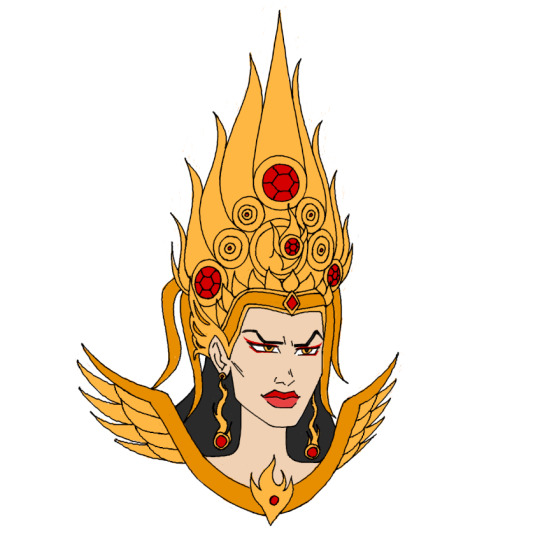
"Just as the world will be reborn in fire, I shall be reborn as the supreme ruler of the world. From this moment on, I will be known as the Phoenix Queen!"
Concept sketch for "Phoenix Queen" Ozai.
In my previous sketch of female Ozai, her crown as Fire Lord is inspired by Chinese fengguan. Since this crown is already intricate, her crown as "Phoenix Queen" needs to be even more elaborate. To embody her vanity, madness, and megalomania, I took inspiration from apsara crowns. By appropriating the costume of an apsara, she visually declares herself an all-powerful goddess of fire. I felt this was fitting, as in ATLA Ozai appropriates Buddha imagery to create a cult of personality that carries into the comics.
The crown that sketched here is not entirely accurate to an apsara crown. Here it is depicted as an enormous, continuous crown, fused together with gold. There are a couple of reasons I decided to do this, but the main reason is because of a scene which occurs in the TV series finale. Before Ozai fights Aang, there is an impressive shot where he is shown standing on an air balloon. In the genderbent AU, I picture female Ozai standing in the same position, wearing this massive crown. From a distance, it should appear like she is wearing a massive flaming bird on her head, or a mass of comets. This was easier to achieve by making her crown a single, fused unit. Additionally, I picture her tearing off her crown in a single smooth moth, then burning off her cape in the moments before her fight with "Aangi". This is also easier to pull off if her crown is a single, fused unit. While this design is not culturally accurate, I think it is appropriate, as she is exploiting the imagery of benevolent goddesses for evil purposes.
Depending on how you view it, her crown is supposed to look like fire, comets, or a flaming phoenix. So much gold and jewelry is employed that it might look garish. When she is turned to the side, the centerpiece of her crown should resemble the head of a phoenix. When viewed from the front, it should resemble a comet, or the Fire Nation symbol that Iroh draws in the sand.
By taking inspiration from Southeast Asian cultures, I hope it helps divorce her from association with Wu Zetian. I don't think it would be appropriate to only have the villains inspired by Southeast Asian cultures, which is one of the reasons why I also took inspiration from Southeast Asian cultures when designing "Zuka""s comics outfit. These decisions are meant to pay homage to the rich heritage of Southeast Asian cultures, rather than associating them with villainy.
An earlier iteration of this design was more inspired by the naga crowns worn by depictions of Queen Soma, where the naga heads were replaced by phoenix tailfeathers. I decided against this, as Queen Soma was a real person and it felt disrespectful to her legacy.
To differentiate her from an adult Azula, I've drawn female Ozai with a more square facial structure, and red eye makeup.
Here is what her hairstyle looks like without the crown:
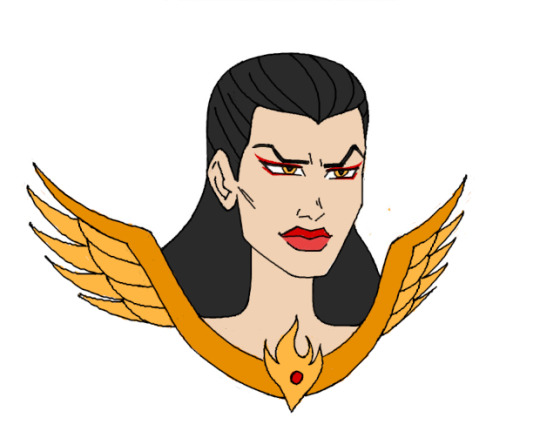
Like what I’m doing? Consider leaving me a donation via Ko-Fi.
#ozai#atla genderbender#avatar the last airbender#gender bender#genderswap#rule 63#genderbend#genderbending#my art#my headcanons
14 notes
·
View notes
Text


Young "Zuka" and "Azulon", as seen in the "Zuka Alone" flashback
Like what I’m doing? Consider leaving me a donation via Ko-Fi.
#avatar the last airbender#zuko#azula#rule 63#genderbend#gender bender#genderswap#atla#atla genderbender#my art
71 notes
·
View notes
Text

ATLA Gender Bender: "Fire Prince Azulon"
Since Azula was named after Azulon, it follows that male Azula would be called Azulon.
Despite being the younger sibling, I imagine that Azulon would be taller than Zuka to symbolize his status as the prodigy child. By age 14, he could be mistaken for the older sibling. He would be noticeably taller than his sister, more skilled in combat, and capable of physically overpowering her. I also think that his physical build would initially be similar to Zuko's at age 13, where he is lean and athletic. By Book 3, his physical build would resemble Zuko in the Beach Episode, or a slightly younger version of him. I do not think he would ever be as bulky as Book 1 Zuko, as it would never be necessary for him to train as hard to become a powerful firebender. If he looks bulky here, it is due to his armor, not his musculature.
I do not think Azulon's appearance would be very different from normal Azula, as she already bears a striking resemblance to Ozai. My intention was for Azulon to resemble a younger Ozai, with Azula's eye color and a touch of Zuko mixed in.
I think it would be interesting if he was almost always seen wearing armor, except for scenes in the beginning of Book 3.
Like what I’m doing? Consider leaving me a donation via Ko-Fi.
#rule 63#avatar the last airbender#atla#atla genderbender#azula#genderbend#genderswap#gender bender#my art#my headcanons
57 notes
·
View notes
Text
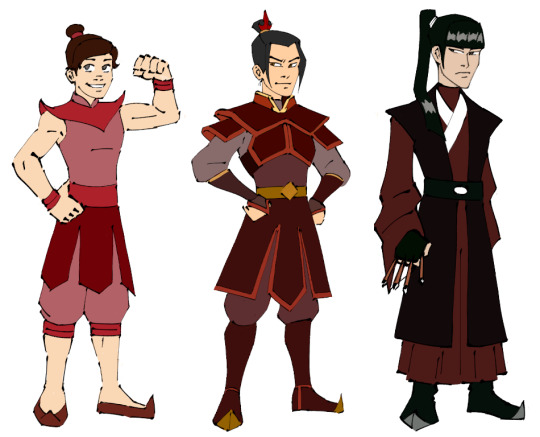
ATLA Gender Bender: Ty Lee, "Azulon", and "Mao"
Azula -> Azulon Mai -> Mao Ty Lee -> Ty Lee
"Azulon" is shown here wearing his Book 2 outfit. This is meant to be similar, but slightly different from Zuko's Book 1 outfit, to suggest that "Azulon" is wearing a nicer set of armor. "Mao" seems to be the most popular name choice for male Mai. Like "Mai", the name "Mao" is Japanese in origin, but it is usually given to girls instead of boys. Still, there are examples of the name "Mao" being given to boys, though it is rare. I don't see the issue of him having an unusual name.
In ATLA, Mai's hairstyle is inspired by Nihongami, specifically fukiwa (see: atlaculture.tumblr.com/post/64…). As a male counterpart, "Mao"'s hairstyle is inspired by the sohatsu style. As it is drawn, this is not historically accurate, due to the length of his hair and his bangs. His clothes are visually inspired by the Korean drama "Hwarang" (2016). Note that the clothes of the hwarang are more Chinese inspired than native Korean. He is wearing a Chinese style banbi. In my mind, it makes sense for him to look like a hwarang, since he'd be an elite warrior youth.
Ty Lee's costume is visually inspired by traditional male Thai dancers and male performers of Phare, the Cambodian Circus. That's why I gave him a muscular appearance. Normally, I dislike it when the male version of a character is very muscular while the female version is not muscular. But in this case, there are too many reasons for male Ty Lee to be muscular in appearance. First, it would be odd for him to be named "Ty Lee" without possessing great physical strength. Second, when he runs off to join the circus it makes sense that he would be trained as a "strongman". Third, from a design perspective, it makes sense for the trio to include a taller, leaner boy and a shorter, more muscular boy. So in this specific case, I think it makes sense for male Ty Lee to have defined muscle structure, even though female Ty Lee does not. Still, he should not be as muscular as Bolin, since he is a couple years younger than Bolin. I tried to give him the musculature of a male circus performer without overdoing it.
I've been imagining P. J. Byrne as the voice of male Ty Lee, Aaron Himelstein as the voice of "Mao", and Jason Marsden as the voice of "Azulon". Like what I'm doing? Consider leaving me a donation via Ko-Fi.
#avatar the last airbender#atla genderbender#genderbend#azula#ty lee#mai#genderswap#rule 63#my art#atla
37 notes
·
View notes
Text

An alternative, scrapped costume for "Firelord Zuka"
Just for fun, I tried to redesign "Zuka"'s Firelord robes.
The layered sleeves are inspired by the clothes worn by Burmese queen Supayalat. Her robes are inspired by Chinese hanfu, specifically the costume of Wu Zetian in "The Empress of China". Her belt is lifted directly from "The Empress of China" (see: dwvyw8kf1avne.cloudfront.net/s…)
I scrapped this design because it is directly contradicted by canon. Fire Lord Izumi wears the same style of robes as the male Fire Lords, which implies that female Fire Lords do not dress differently from male Fire Lords. I am still fond of this design, as the costumes of female royalty provide a lot of inspiration, and I prefer the look of more saturated reds.
Here is a side-by-side comparison with the canon Firelord robes:

Like what I’m doing? Consider leaving me a donation via Ko-Fi.
36 notes
·
View notes
Text


ATLA Gender Bender: Water Siblings
Rough sketches of their outfits from the Comics continuity.
Like what I’m doing? Consider leaving me a donation via Ko-Fi.
#avatar the last airbender#sokka#katara#atla genderbender#genderswap#rule 63#gender bender#genderbend#genderbends#my art#atla
58 notes
·
View notes
Text

ATLA Gender Bender: "Sukio"
"There's no way a bunch of girls took us down!"
"Who said we're girls?"
With Suki as a male, I would reimagine the culture of Kyoshi Island. Instead of being a band of female warriors, the Kyoshi Warriors are boys who cross dress to honor Avatar Kyoshi. Their culture is supposed to be a fusion of samurai and onnagata (see: en.wikipedia.org/wiki/Onnagata).
I find this appropriate, because Avatar Kyoshi's makeup is inspired by kabuki (see: atlaculture.tumblr.com/post/72…). The headdress worn by the Kyoshi warriors is based on the legendary female samurai Tomoe Gozen (see: atlaculture.tumblr.com/post/64…). Tomoe Gozen was traditionally portrayed by a male actor (onnagata) in kabuki (see: www.roningallery.com/working_4…) For this reason, I did not change the costume for the male Kyoshi warriors.
The "Kyoshi Island" episode would teach a different, but equally important lesson about gender equality.
Suki's name comes from the Japanese word 好き (suki). "Sukio" is a masculine Japanese name.
Like what I’m doing? Consider leaving me a donation via Ko-Fi.
#avatar the last airbender#suki#atla#atla genderbender#gender bender#genderbend#genderswap#rule 63#my art
24 notes
·
View notes